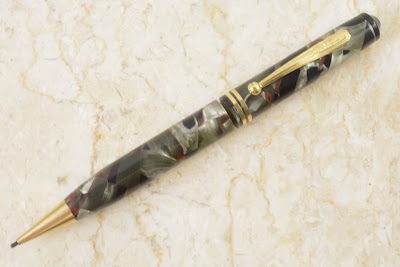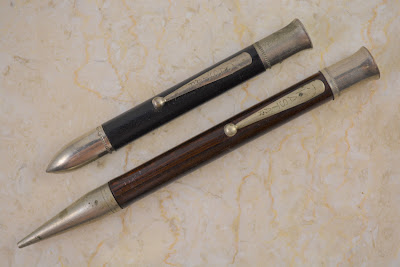This article has been edited and included in The Leadhead's Pencil Blog Volume 5; copies are available print on demand through Amazon here, and I offer an ebook version in pdf format at the Legendary Lead Company here.
If you don't want the book but you enjoy this article, please consider supporting the Blog project here.
So the story behind it is one well worth telling right about now.
After a few days of furious work, I've been able to restore all the articles that ran between January, 2013 and April, 2013. That leaves only the initial run of articles, which started in November, 2011 and ran daily for a year.
Still, that first run is more than three quarters of what was lost. But it wasn't really lost.
When I wrapped up the first series of articles here, I had an idea to reproduce that first year of articles in book form, with the unimaginative title The Leadhead's Pencil Blog. It took about a month, but I had a PDF generated and ready to print by December, 2012:
I even generated a comprehensive subject matter index for it:
I had the printer lined up to publish it, and I sent out copies of the PDF to publishers in the hopes of getting the project picked up. At the last minute, just as I was ready to pull the trigger on another self-publishing project, I stopped the press. Schiffer Publishing called, and they were interested in the book -- at their cost, paying me royalties on sales.
We spent weeks negotiating a contract, and after Schiffer's initial runthrough of my manuscript, they delivered a bit of bad news: the images I had shot were not high enough resolution for their purposes, and if the project was going to proceed further, I would need to reshoot the images.
1,791 images.
What the hell, I thought. This is my big break! I took off nearly a month from my day job as an attorney and spent the time in my basement, painstakingly recreating all the shots I had taken during that first year.
Then came the next request: instead of printing the articles in sequential order, could I reorganize the book into sections grouped by subject?
Why sure, I said. I suppose it's possible that they did not detect sarcasm as I expressed my delight at the opportunity to rewrite a 425-page book. But I did it. What the hell, I thought again . . . I've come this far, and (sigh) I suppose this is still my big break.
After I reshot, reorganized, reformatted and then finally reaquainted myself with my day job, I was encouraged to see that things were starting to happen. Schiffer had renamed the book American Mechanical Pencils, designed a cover, obtained the ISBN number and the book was showing up in the company's catalog online for a release sometime around the fall of 2014:
With cover art on file and an ISBN number, the book got picked up by Amazon and other online book retailers, with "coming soon" announcements across the internet. And then . . .
nothing happened.
I finally contacted Schiffer to ask what was going on with the project. The editor assigned to it was at first apologizing that he dropped the ball, then explaining how busy he was and promising to get to it within one week, then two weeks, then just "soon." I liked those conversations a lot better than the one we had after he finally got around to doing his job.
He called me up and announced that he didn't think the book I had written had broad enough commercial appeal. He suggested that maybe I could write a different book about mechanical pencils for Schiffer, and if I did maybe they would publish that one instead.
He called me up and announced that he didn't think the book I had written had broad enough commercial appeal. He suggested that maybe I could write a different book about mechanical pencils for Schiffer, and if I did maybe they would publish that one instead.
I was furious, and I faced a choice. If Schiffer didn't publish my book within 18 months, I could terminate my contract. If I said "oh, ok, let me write a book for you about mechanical pencils," then under the contract arguably anything I wrote on the subject would belong to Schiffer, and I couldn't publish it at the blog or anywhere else until Schiffer had spent another 18 months deciding whether to print it.
Yet this was my big break, right?
I'm really proud of myself for what I did next.
I'm really proud of myself for what I did next.
I told Schiffer to get stuffed. So much for my big break.
American Mechanical Pencils remains a ghost book still floating around on the internet. I still get occasional inquiries about it (one guy even sent me a payment to reserve a copy that I had to refund), and to this day Amazon still shows the book being released in October, 2014 with a notation that it is currently out of stock:
In fact, the project as I originally envisioned it is also still floating around, because I had obtained my own ISBN when I thought I was self publishing it. Here's the google books entry:
Now I'm wondering if the Google catastrophe that wiped out such a large part of my blog might be a sign of things to come -- and a sign that this old ghost may be worth bringing back to life. All the images that were lost were images too small to count towards storage limitations on Google Drive, and I suspect that Google would rather host a smaller number of larger images than an unlimited number of little ones that "don't count."
I've worked really, REALLY hard to locate and restore images for all the 2013 articles . . . but with a click of the button somewhere in googleland, they could be wiped out again, maybe tomorrow, maybe in another five years. Do I really want to spend countless hours messing with pictures and formatting for that first run of articles again, with no guarantee that the changes will ever achieve that permanence I was looking for?
Hell, for that matter, would I ever have written and posted all those articles in the first place if I knew this was going to happen?
What I do know is this: the only way the book I've got waiting in the wings will see the light of day is if I print it myself. If I restore the images from that first year of articles, (1) nobody will buy the book and (2) Google might knock them right back out again anyway.
So I'm going gravedigging next week, looking for ways that the book version of The Leadhead's Pencil Blog can finally become a reality. Maybe that old ghost has some life in it after all!




















































